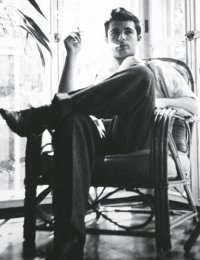Bill Ward (cartoonist)
| Bill Ward | |
|---|---|
 | |
| Born | William Hess Ward March 6, 1919 New York City, U.S. |
| Died | November 17, 1998 (aged 79) New Jersey, U.S.[1] |
| Area(s) | Cartoonist, Writer, Penciller |
| Pseudonym(s) | Bill |
Notable works | Torchy |
William Hess Ward[1] (March 6, 1919 – November 17, 1998),[2] was an American cartoonist notable as a good girl artist and creator of the risqué comics character Torchy.
Biography
Early life and career
Born in Brooklyn, New York, Ward grew up in Ridgewood, New Jersey, where his father was an executive with the United Fruit Company.[1]
At age 17, Ward, already an art hobbyist, began his professional career by illustrating "beer jackets", a type of white denim jacket with text or design printed or drawn on the back; Ward charged one dollar a jacket, and by his own count drew hundreds during that summer.[2] He went on to attend Pratt Institute in Brooklyn, New York City, New York, where one classmate was future naturist painter Bob Kuhn.[2] Ward graduated in 1941, and through the university's placement bureau obtained a Manhattan art-agency job at $18 a week, sweeping floors, running errands and serving as an art assistant. He was fired after accidentally cutting in half a finished Ford automobile illustration with a matte knife.[2]

Still rooming at his college
Ward's first credited works are writing and drawing an episode each of the two-page
Shortly thereafter,
Torchy
Torchy made her comic-book debut as star of a backup feature in Quality Comics' Doll Man #8 (Spring 1946), and continued in all but three issues through #28 (May 1950), as well as in Modern Comics #53-89 (Sept. 1946 - Sept. 1949). A solo series, Torchy, ran six issues (Nov. 1949 - Sept. 1950).[3][5]
Several Torchy stories, including some Fort Hamilton strips, were reprinted in
Ward drew an original cover featuring Torchy for Robert M. Overstreet's
Later career
Ward's last confirmed American comic-book work is at least one
Ward turned to magazine cartooning afterward, doing humorous spot illustrations, some featuring Torchy, for such publications as editor Abe Goodman's
He did very occasional comic-book humor stories, such as the four-page "Play Pool" in Humor-Vision's
Ward wrote and illustrated erotic stories for such
In a rare turn doing a mainstream comics character, Ward drew the four-page part one of a
References
- ^ a b c Kroll, Eric. "The Best Eye Candy Money Can Buy: The Life of Bill Ward, Good Girl Artist". Taschen.com. Archived from the original on March 6, 2009. Retrieved 2011-01-14. Additional WebCitation archive, February 8, 2011.
- ^ a b c d e f Ward, Bill (n.d.). "The Man Behind Torchy: Bill Ward". Women of Ward (official site). Archived from the original on October 20, 2014.
- ^ a b c d e f g h Bill Ward at the Grand Comics Database
- ^ Military Comics at the Grand Comics Database
- ^ Torchy at Don Markstein's Toonopedia. Archived from the original on January 4, 2017.
- ^ Allender, Jeff (ed.). "Bill Ward: 50 Fabulous Years of Torchy Comic Images - 1994". (Trading-card checklist) Jeff Allender's House of Checklists. Archived from the original on January 17, 2008.
- ^ Kroll, p. 3. Link retrieved 2007-12-06. Archived 2011-05-17 at the Wayback Machine
- BuzzFeed.com. Archivedfrom the original on March 4, 2016. Retrieved January 4, 2016.
- ^ Ward, Bill. "Cover" Screw March 7, 1994 (Issue 1305); New York: Milky Way Productions
Further reading
- Kroll, Eric, and Martin Holz, ed., The Wonderful World of Bill Ward, King of the Glamour Girls (ISBN 978-3-8228-1290-7
- Chun, Alex, ed., The Pin-Up Art of Bill Ward (ISBN 978-1-56097-787-2
- Chun, Alex, ed., The Glamour Girls of Bill Ward (Fantagraphics, 2007), ISBN 978-1-56097-846-6
External links
- Bill Ward at the Lambiek Comiclopedia
- Agena, Eric, ed. "Other Adult Publication GGA - Bill Ward", ComicStripFan.Com, n.d. WebCitation archive.
- Courtney, Bill. "The Sexy and Patriotic Cartoon World of Bill Ward", The Uranium Cafe (fan site), June 18, 2007. WebCitation archive.
- "Did You Know? Torchy Todd", Scoop (column), Diamond Galleries, December 25, 2003. WebCitation archive.
